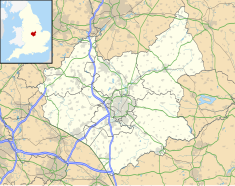
Coalville is a town in the district of North West Leicestershire, Leicestershire in the East Midlands of England. In 2011, it had a population of 34,575. It lies on the A511 trunk road between Leicester and Burton upon Trent, close to junction 22 of the M1 motorway where the A511 meets the A50 between Ashby-de-la-Zouch and Leicester. It borders the upland area of Charnwood Forest to the east of the town.

Guildhall is a municipal building in the Moorgate area of the City of London, England. It is off Gresham and Basinghall streets, in the wards of Bassishaw and Cheap. The building has been used as a town hall for several hundred years, and is still the ceremonial and administrative centre of the City of London and its Corporation. It should not be confused with London's City Hall, the administrative centre for Greater London. The term "Guildhall" refers both to the whole building and to its main room, which is a medieval great hall. The nearest London Underground stations are Bank, St Paul's and Moorgate. It is a Grade I-listed building.

Birmingham City Council House in Birmingham, England, is the home of Birmingham City Council, and thus the seat of local government for the city. It provides office accommodation for both employed council officers, including the Chief Executive, and elected council members, plus the council chamber, Lord Mayor's Suite, committee rooms and a large and ornate banqueting suite, complete with minstrel's gallery. The first-floor's exterior balcony is used by visiting dignitaries and victorious sports teams, to address crowds assembled below. The Council House, which has its own postcode, B1 1BB, is located in Victoria Square in the city centre and is a Grade II* listed building.

The Civic Centre is a municipal building located in the Cultural Quarter area within the city of Southampton, England. It comprises offices occupied by Southampton City Council, the SeaCity Museum, the Guildhall, the Southampton City Art Gallery, and the city library. It was designed by the English architect Ernest Berry Webber in the Classical style in 1929 and constructed over a ten-year period. It was completed in 1939. Pevsner's Hampshire: South describes it as "the most ambitious civic building erected in the provinces in the interwar years". It was designated as a Grade II* listed building in 1980.

The Guildhall in Leicester, England, is a timber framed building, with the earliest part dating from c. 1390. The Guildhall once acted as the town hall for the city until the current one was commissioned in 1876. It is located in the old walled city, on a street now known as Guildhall Lane. It was used first as the meeting place for the Guild of Corpus Christi and then later for the more formal Corporation of Leicester. The hall was used for many purposes, including council meetings, feasts, as a courtroom, and for theatrical performances; the ultimatum given to the city during English Civil War was discussed here. It is a Grade I listed building, and the surrounding area, also including the Cathedral of St Martin's, is a conservation area, one of three in Leicester.

Leicester City Council is a unitary authority responsible for local government in the city of Leicester, England. It consists of 54 councillors, representing 22 wards in the city, overseen by a directly elected mayor. It is currently controlled by the Labour Party and has been led by Mayor Sir Peter Soulsby since his election on 6 May 2011. The main council offices are at City Hall on Charles Street, but council meetings are held in the 19th-century Town Hall.

The Guildhall is one of the main office buildings of the City and County of Swansea Council. The Guildhall complex, which includes the City Hall, Brangwyn Hall and the County Law Courts for Swansea, is a Grade I listed building.

York Guildhall is a municipal building located in St Martins Courtyard, Coney Street, in York. Located behind the Mansion House, it is a Grade I listed building.

Portsmouth Guildhall is a multi-use building in the centre of Portsmouth, UK, located on a pedestrian square close to the Portsmouth and Southsea railway station. Constructed in 1890, the building was known as Portsmouth Town Hall until 1926. It was heavily damaged by bombing during the Second World War and largely rebuilt during the 1950s by the English architect Ernest Berry Webber. It now operates as a concert, wedding and conference venue. It is a Grade II listed building.

The City Rooms is located in the heart of the City of Leicester in England. It has been designated by English Heritage as a Grade I listed building.
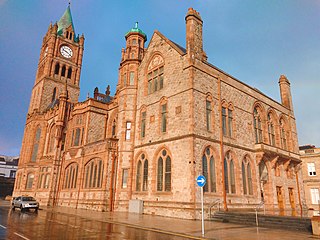
The Guildhall in Derry, Northern Ireland, is a guildhall in which the elected members of Derry City and Strabane District Council meet. It is a Grade A listed building.

Cambridge Guildhall is a civic building in the centre of the historic city of Cambridge, England. It includes two halls, The Large Hall and The Small Hall, and is used for many disparate events such as comedy acts, conferences, craft fairs, live music, talks, and weddings. It is also used by the University of Cambridge for certain examinations. It is owned and managed by the Cambridge City Council, and it is their seat of government. The Guildhall is located on the south side of Market Hill, the market square in Cambridge, between Peas Hill to the west and Guildhall Street to the east. It is a Grade II listed building.

Totnes Guildhall is a 16th-century Tudor historic guildhall, magistrate's court, and prison, in the town of Totnes, south Devon, in southwest England. It is a Grade I listed building.
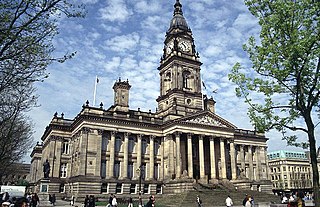
Bolton Town Hall in Victoria Square, Bolton, Greater Manchester, England, was built between 1866 and 1873 for the County Borough of Bolton to designs by William Hill of Leeds and George Woodhouse of Bolton. The town hall was extended in the 1930s to the designs of Bradshaw, Gass and Hope and has been designated a Grade II* listed building by English Heritage.
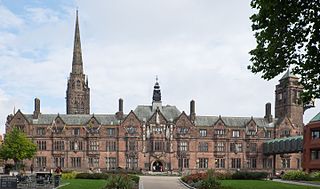
The Council House, Coventry is a Tudor Revival style civic building which acts as the meeting place of Coventry City Council and was built in the early 20th century. It is a Grade II-listed building.
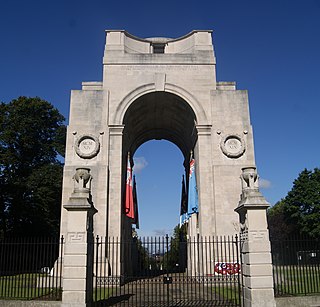
The Arch of Remembrance is a First World War memorial designed by Sir Edwin Lutyens and located in Victoria Park, Leicester, in the East Midlands of England. Leicester's industry contributed significantly to the British war effort. A temporary war memorial was erected in 1917, and a committee was formed in 1919 to propose a permanent memorial. The committee resolved to appoint Lutyens as architect and to site the memorial in Victoria Park. Lutyens's first proposal was accepted by the committee but was scaled back and eventually cancelled due to a shortage of funds. The committee then asked Lutyens to design a memorial arch, which he presented to a public meeting in 1923.

The Guildhall is a town hall and community building in the town of Chard in the English county of Somerset.

Plymouth Guildhall is located on Guildhall Square in the city centre of Plymouth, Devon, England. It is a Grade II listed building.
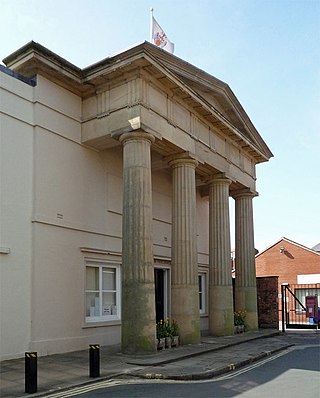
The Guildhall is a municipal facility at Register Square in Beverley, East Riding of Yorkshire, England. It is a Grade I listed building.
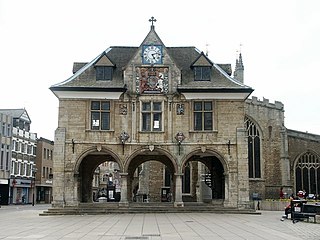
Peterborough Guildhall is a municipal building in Cathedral Square, Peterborough, Cambridgeshire, England. It is a Grade II* listed building.

